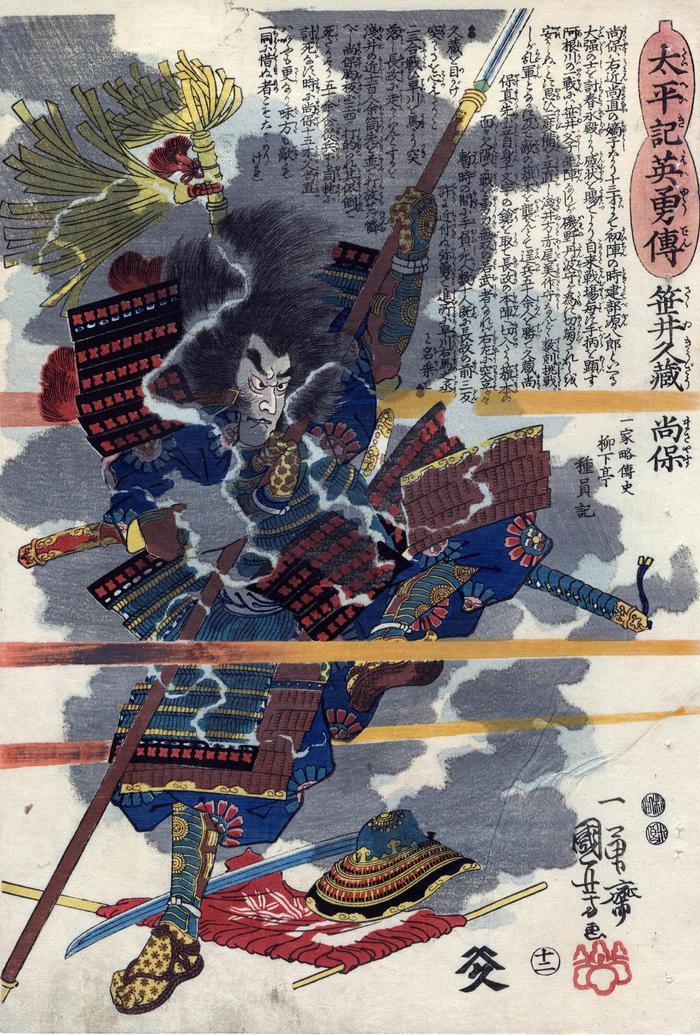Utagawa Kuniyoshi (歌川国芳) (artist 11/15/1797 – 03/05/1861)
Sasai Kyūzō Masayasu (笹井久藏尚保) at the Battle of the Anegawa in 1570 from Heroic Stories of the Taiheiki (Taiheiki eiyū den - 太平記英勇傳)
1848 – 1849
10.75 in x 14.5 in (Overall dimensions) color woodblock print
Signed: Ichyūsai Kuniyoshi ga
一勇斎国芳画
Artist's seal: kiri
Publisher: Yamamotoya Heikichi
(Marks 595 - seal 04-007)
Censor seals: Mera and Murata
Number 12 in a circle - 十二
Text: Ryūkatei Tanekazu (柳下亭種員)
British Museum
Tokyo Metropolitan Library
Muzeum Sztuki i Techniki Japońskiej Manggha, Krakow
Victoria and Albert Museum
Art Gallery of South Australia
Art Gallery of New South Wales
Ashmolean Museum, Oxford
Museum of Fine Arts, Houston
Museum of Oriental Art, Venice (via Ritsumeikan University)
Koninklijke Musea voor Kunst en Geschiedenis, Brussel (via Ritsumeikan University)
Náprstek Museum
Museum für Ostasiatische Kunst, Köln The Taiheiki was written in the late fourteenth century and recounts a series of wars between the Northern Court of Ashikaga Takauji in Kyoto, and the Southern Court of Emperor Go-Daigo in Yoshino. However, this series of prints portrays characters from the civil wars of the sixteenth century, with the participant’s names altered.
****
The text on the print reads:
Masayasu was Ukon Masanao's... eldest son. In his first battle, at the age of thirteen, he defeated Tatebe Genpachirō, who was known as a warrior of great strength. Lord Harunaga... rewarded [Masayasu] with a letter of commendation, and thereafter, in every fight, he distinguished himself by glorious deeds. In the battle at the Anegawa river... the Sasai, father and son, were in the vanguard but had been crushed by lsono Tanba-no kami... and, distressed by this, they once again rearranged their defence. Asai [Nagamasa 's]... warrior Akao Mimasaka-no kami, scoring numerous victories, entered the battle and a mixed fight began. Then, deciding to attack the enemy headquarters, Kyūzō Masayasu himself led fifty superior and daring soldiers. With a jūmonji lance in his hands he cut his way into Nagamasa's headquarters, sundering one from another in the main regiment. A young warrior of matchless courage, he stabbed right and left and in a short time he had wounded and killed dozens of men. He was now only three tan away from Nagamasa and becoming more and more inspired, he advanced. At that moment Hayakawa Umanojō announced his name, took aim at Masayasu, and trying to stab him, engaged with him twice and thrice. [Masayasu] thrust Hayakawa down from his horse and was about to rush at Nagamasa when over a hundred of Asai's guards lined up their gun muzzles and fired. Four bullets hit the breast of the unfortunate Masayasu, and he fell dead. And fifty of his followers had also fallen in that way at the battlefield. Masayasu was then fifteen years old and everyone grieved over him, comrades and enemies alike, to say nothing of Masayasu 's father Masanao.From Heroes of the Grand Pacification: Kuniyoshi’s Taiheiki eiyū den by Elena Varshavskaya (2006, Hotei Publishing, Amsterdam, 2006).
Number 12 in the series.
Historical character: Sakai Kyūzō Narishige (1555? - 1570).
****
This print was used to illustrate the cover of Kuniyoshi's Heroes of China & Japan by Oliver Impey and Mitsuke Watanabe, 2006.
****
Illustrated:
1) In a full page color reproduction in Ukiyo-e to Shin hanga: The Art of Japanese Woodblock Prints, Mallard Press, 1990, p. 146.
2) In color in Japanese Prints by Catherine David, 2010, Éditions Place des Victoires, p. 402.
3) In black and white in Utagawa Kuniyoshi, Springfield Museum of Art, 1980, #181.
4) In a black and white reproduction in Kuniyoshi: The Warrior Prints by B.W. Robinson, fig. 9, p. 15, S62.36. Robinson wrote on page 9: "When one looks at, say, 'Kintoki and the carp' (S1d.1) or 'The death of Masayasu' (S62.36), and one tries to work out exactly how the effects of falling water in the one, and in the other the disintegration of a spearman in a volley of musketry, are produced, the technical mastery and inventiveness displayed by these simple craftsmen almost takes one's breath away. How one would have liked to have overheard the discussions between them that must have preceded the production of such prints as these!"
5) in color in Catalogue of Japanese Art in the Náprstek Museum published by The International Research Center for Japanese Studies: Nichibunken Japanese Studies Series 4, 1994, p. 94.
6) in a full page black and white reproduction in Kuniyoshi by B. W. Robinson, London, Her Majesty's Stationery Office, 1961, #62.
warrior prints (musha-e - 武者絵) (genre)
Yamamotoya Heikichi (山本屋平吉) (publisher)
Taiheiki (太平記) (genre)
Ryūkatei Tanekazu (柳下亭種員 - 1807-58) (author)
